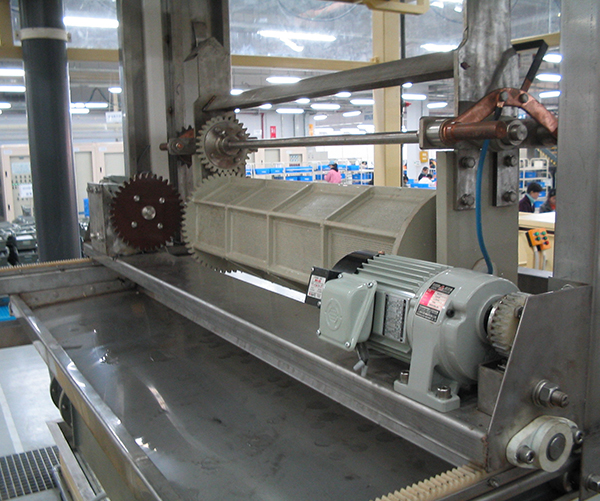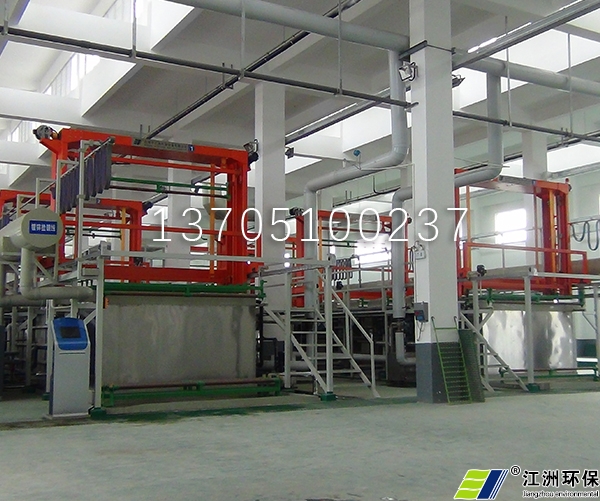In addition to some common large electroplating processes Electroplating equipment In addition, what other auxiliary equipment is included?
In order to complete the electroplating process according to the process requirements, it is not enough to have power supply and plating tank, but also some auxiliary equipment to ensure the normal production of electroplating. It includes heating or cooling equipment, cathode moving or stirring equipment, plating solution circulation or filtering equipment, and the necessary accessories of the plating tank, such as electrode rod, electrode wire, anode and anode basket, plating hanging appliance, etc. [2]
1. Heating or cooling device
Since the plating solution needs to work at a certain temperature, the plating tank should be equipped with heating equipment. For example, the bath temperature for bright nickel plating needs to be kept at 50 ℃, the temperature for chromium plating needs to be 50-60 ℃, and the temperature for acid bright copper plating or bright silver plating needs to be within 30 ℃. In this way, these process requirements need to be met by heat exchange equipment. Generally, direct heating is used for heating.
2. Cathode moving or stirring device
Some plating seeds or most plating seeds need the cathode to be in the swing state, which can increase the working current, make the plating solution play its due role (usually brightness and dispersion ability), and prevent the tip, corner plating and scorching.
Some plating seeds can use mechanical or air agitation instead of cathode movement. Mechanical mixing is carried out by a mixer made of corrosion-resistant materials, usually driven by a motor, but the speed cannot be too high. The compressed air filtered to remove oil stains is used for air agitation.
3. Filtering and circulating filtering equipment
In order to ensure the electroplating quality, the plating solution needs to be filtered regularly. Some plating seeds are also required to be circularly filtered during operation. The filter is a common equipment in the chemical industry, so it is an industry standard equipment. However, it is also based on the enterprise's own standards. The filter can be selected according to the type of plating, the size of the plating tank and the needs of the process.
4. Necessary accessories for electroplating tank
The electroplating tank must be equipped with accessories including anode and anode basket or anode hook, electrode rod, power connection wire, etc. In order to save investment, some factories can hang the anode directly to the plating tank with a hook instead of an anode basket, but at least the anode sleeve should be put on.
The anode basket is mostly made of titanium material, and a few plating seeds can also be made of stainless steel or steel.
The electrode rod is a conductive rod used to hang the anode and cathode and connect with the power supply. It is usually made of copper rod or brass rod, slightly longer than the plating bath. The diameter depends on the current, but it should be at least 5cm.
The key of the power connection line is to ensure that it can pass the required current. It is better to use copper plate or multi strand cable, which must meet the requirements for its cross-sectional area.
5. Hanger
Hanger is the most important auxiliary tool for electroplating processing. It is a tool to ensure a good connection between the electroplated products and the cathode, and it also has a direct impact on the distribution of electroplated coatings and work efficiency. There are professional hanger manufacturers and suppliers that provide universal hangers in the industry and design and customize hangers according to user needs.

6. Cleaning equipment before plating
Application of ultrasonic cleaning in electroplating process
The pretreatment process of product electroplating is very important. Generally, the traditional process uses acid solution to treat the workpiece, which causes heavy environmental pollution and poor working environment. At the same time, the biggest disadvantage is that the residual acid after pickling and rust removal of parts with complex structure is difficult to clean. After the workpiece is plated for a short time, corrosion occurs along the seam, which damages the surface of the electroplated coating and seriously affects the appearance and internal quality of the product. After the application of ultrasonic cleaning technology to the pretreatment of electroplating, not only can the dirt in the surface and gap of objects peel off quickly, but also the electroplating layer of electroplated parts is firm and will not rust back.
The cavitation effect of ultrasonic wave in the liquid can be used to clean the oil stain on the surface of the workpiece. With proper cleaning agent, the workpiece surface can be quickly treated with high cleanliness.
Electroplating process requires high cleanliness of workpiece surface, and ultrasonic cleaning technology is an ideal technology to meet this requirement. Using ultrasonic cleaning technology can replace solvent to clean oil stains; It can replace electrolytic degreasing; It can replace strong acid etching to remove rust and oxide scale on the surface of carbon steel and low alloy steel.







